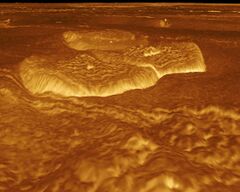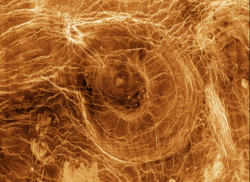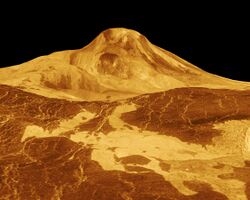Volcanology of Venus
Topic: Astronomy
 From HandWiki - Reading time: 7 min
From HandWiki - Reading time: 7 min
The surface of Venus is dominated by volcanic features and has more volcanoes than any other planet in the Solar System. It has a surface that is 90% basalt, and about 65% of the planet consists of a mosaic of volcanic lava plains, indicating that volcanism played a major role in shaping its surface. There are more than 1,000 volcanic structures and possible periodic resurfacing of Venus by floods of lava. The planet may have had a major global resurfacing event about 500 million years ago,[1] from what scientists can tell from the density of impact craters on the surface. Venus has an atmosphere rich in carbon dioxide, with a density that is 90 times greater than Earth's atmosphere.
Even though there are over 1,600 major volcanoes on Venus, none are known to be erupting at present and most are probably long extinct.[2] However, radar sounding by the Magellan probe revealed evidence for comparatively recent volcanic activity at Venus's highest volcano Maat Mons, in the form of ash flows near the summit and on the northern flank. Although many lines of evidence suggest that Venus is likely to be volcanically active, present-day eruptions at Maat Mons have not been confirmed. Nevertheless, other more recent studies, in January 2020, suggests Venus is currently volcanically active.[3][4]
Types of volcanoes
Venus has shield volcanoes, widespread lava flows and some unusual volcanoes called pancake domes and "tick-like" structures which are not present on Earth. Pancake dome volcanoes are up to 15 km (9.3 mi) in diameter and less than 1 km (0.62 mi) in height and are 100 times larger than those formed on Earth. They are usually associated with coronae and tesserae (large regions of highly deformed terrain, folded and fractured in two or three dimensions, are unique to Venus). The pancakes are thought to be formed by highly viscous, silica-rich lava erupting under Venus's high atmospheric pressure.
The "tick-like" structures are called scalloped margin domes. They are commonly called ticks because they appear as domes with numerous legs. They are thought to have undergone mass wasting events such as landslides on their margins. Sometimes deposits of debris can be seen scattered around them.

On Earth, volcanoes are mainly of two types: shield volcanoes and composite or stratovolcanoes. The shield volcanoes, for example those in Hawaii, eject magma from the depths of the Earth in zones called hot spots. The lava from these volcanos is relatively fluid and permits the escape of gases. Composite volcanos, such as Mount St. Helens and Mount Pinatubo, are associated with tectonic plates. In this type of volcano, the oceanic crust of one plate is sliding underneath the other in a subduction zone, together with an inflow of seawater, producing a gummier lava that restricts the exit of the gases, and for that reason, composite volcanoes tend to erupt more violently.

On Venus, where there are no tectonic plates or seawater, volcanoes are mostly of the shield type [citation needed]. Nevertheless, the morphology of volcanoes on Venus is different: on Earth, shield volcanoes can be a few tens of kilometres wide and up to 10 km (6.2 mi) high in the case of Mauna Kea, measured from the sea floor. On Venus, these volcanoes can cover hundreds of kilometres in area, but they are relatively flat, with an average height of 1.5 km (0.93 mi). Large volcanoes cause the Venusian lithosphere to flex downward because of their enormous vertical loads, producing flexural moats and/or ring fractures around the edifices.[5] Large volcano edifice loading also causes magma chambers to fracture in a sill-like pattern, affecting magma propagation beneath the surface.[6]
Other unique features of Venus's surface are novae (radial networks of dikes or grabens) and arachnoids. A nova is formed when large quantities of magma are extruded onto the surface to form radiating ridges and trenches which are highly reflective to radar. These dikes form a symmetrical network around the central point where the lava emerged, where there may also be a depression caused by the collapse of the magma chamber.
Arachnoids are so named because they resemble a spider's web, featuring several concentric ovals surrounded by a complex network of radial fractures similar to those of a nova. It is not known whether the 250 or so features identified as arachnoids actually share a common origin, or are the result of different geological processes.[7]
Recent volcanic activity
Volcanism on Venus has taken place within the last 2.5 million years; however, there is no absolute proof that any volcano on Venus has erupted recently. Recent radar imagery shows more than 1,000 volcanic structures and evidence of possible periodic resurfacing of the planet by floods of lava. In addition to the radar images, there is supporting evidence that volcanism has taken place, including an unusual change in the amount of sulphur dioxide gas in the upper atmosphere. Sulphur dioxide is an important component of volcanic outgassing. However, the sulphur dioxide in the lower atmosphere remains stable. This could mean that a change in the global atmosphere caused the sulphur dioxide concentration to increase above the clouds. Even though the change in the atmosphere may be evidence that there have been volcanoes that erupted in Venus, it is difficult to determine whether they occurred or not.[7] In March 2014, the first direct evidence for ongoing volcanism was located, in the form of infrared "flashes" over the edges of rift zone Ganis Chasma, near the shield volcano Sapas Mons. These flashes were detectable during two or three consequent Earth days in 2008 and 2009 and are thought to be caused either by hot gases or lava released from volcanic eruptions.[8] Scientists suspect that there are three volcanoes that may be active: Maat Mons, Ozza Mons and Sapas Mons.[9][10]
Lightning
Lightning on Venus may serve as a diagnostic of volcanism or atmospheric convection, so some effort has been devoted to detecting possible lightning on Venus.[11] No lightning has been directly observed, but the most compelling evidence is the very low frequency (VLF) radio emissions recorded beneath the clouds by all four of the Venera landers.[11] The Japanese orbiter Akatsuki is currently searching for visible lightning on Venus, among other science objectives.[12]
Exploration
In April 2010, Suzanne E. Smrekar et al. published that Venus Express observed three volcanoes that have had eruptions about 250,000 years ago or less, which suggests that Venus is periodically resurfaced by lava flows.[13][14] She has proposed two missions to Venus to elucidate the planet: Venus Origins Explorer (VOX), and VERITAS. Meanwhile, the Japanese spacecraft Akatsuki has been orbiting Venus since December 2015 and one of its goals is to scan for active volcanism using its infrared cameras.[15][16]
See also
- Volcanology of Io
- Volcanology of Mars
References
- ↑ D.L. Bindschadler (1995). "Magellan: A new view of Venus' geology and geophysics". American Geophysical Union. http://www.agu.org/journals/rg/rg9504S/95RG00281/index.html. Retrieved 2007-09-13.
- ↑ Volcanoes on Venus Retrieved on 2007-08-18
- ↑ Hall, Sannon (9 January 2020). "Volcanoes on Venus Might Still Be Smoking - Planetary science experiments on Earth suggest that the sun's second planet might have ongoing volcanic activity.". The New York Times. https://www.nytimes.com/2020/01/09/science/venus-volcanoes-active.html. Retrieved 10 January 2020.
- ↑ Filiberto, Justin (3 January 2020). "Present-day volcanism on Venus as evidenced from weathering rates of olivine". Science 6 (1): eaax7445. doi:10.1126/sciadv.aax7445. PMID 31922004.
- ↑ [McGovern and Solomon, 1998]
- ↑ Galgana (2011). "Evolution of large Venusian volcanoes". American Geophysical Union. http://europa.agu.org/?view=article&uri=/journals/je/je1103/2010JE003654/2010JE003654.xml&t=2011,galgana. Retrieved 2011-07-25.
- ↑ 7.0 7.1 A New Episode of Volcanism on Venus. ESA: Science and technology. December 2, 2012
- ↑ "Hot lava flows discovered on Venus". 2015. http://www.esa.int/Our_Activities/Space_Science/Venus_Express/Hot_lava_flows_discovered_on_Venus.
- ↑ Venus Volcano Watch. Mattei, M. F. The Journal of the Association of Lunar and Planetary Observers, Volume 53, Number 2, p.6. March 2011.
- ↑ Venus Volcano Observing List for Spring 2018. Mattei, M. F. The Journal of the Association of Lunar and Planetary Observers, Volume 60, Number 2, p.38-39. March 2018.
- ↑ 11.0 11.1 Lightning detection on Venus: a critical review. Ralph D. Lorenz. Prog Earth Planet Sci (2018) 5: 34. 20 June 2018. doi:10.1186/s40645-018-0181-x
- ↑ Hunt for optical lightning flash in Venus using LAC onboard Akatsuki spacecraft. Takahashi, Yukihiro; Sato, Mitsuteru; Imai, Masataka. 19th EGU General Assembly, EGU2017, proceedings from the conference held 23–28 April 2017 in Vienna, Austria., p.11381.
- ↑ Smrekar, Suzanne E.; Stofan, Ellen R.; Mueller, Nils; Treiman, Allan; Elkins-Tanton, Linda; Helbert, Joern; Piccioni, Giuseppe; Drossart, Pierre (2010), "Recent Hot-Spot Volcanism on Venus from VIRTIS Emissivity Data", Science Forthcoming (5978): 605–8, doi:10.1126/science.1186785, PMID 20378775, Bibcode: 2010Sci...328..605S.
- ↑ Overbye, Dennis (April 9, 2010), "Spacecraft Spots Active Volcanoes on Venus", New York Times, https://www.nytimes.com/2010/04/10/science/space/10venus.html.
- ↑ Initial products of Akatsuki 1-μm camera. Earth, Planets and Space. 2018, vol. 70, nbr. 6. doi:10.1186/s40623-017-0773-5
- ↑ "AKATSUKI orbit control at perihelion". JAXA. 1 November 2011. http://www.jaxa.jp/projects/sat/planet_c/index_e.html. Retrieved 3 December 2011.
 KSF
KSF


